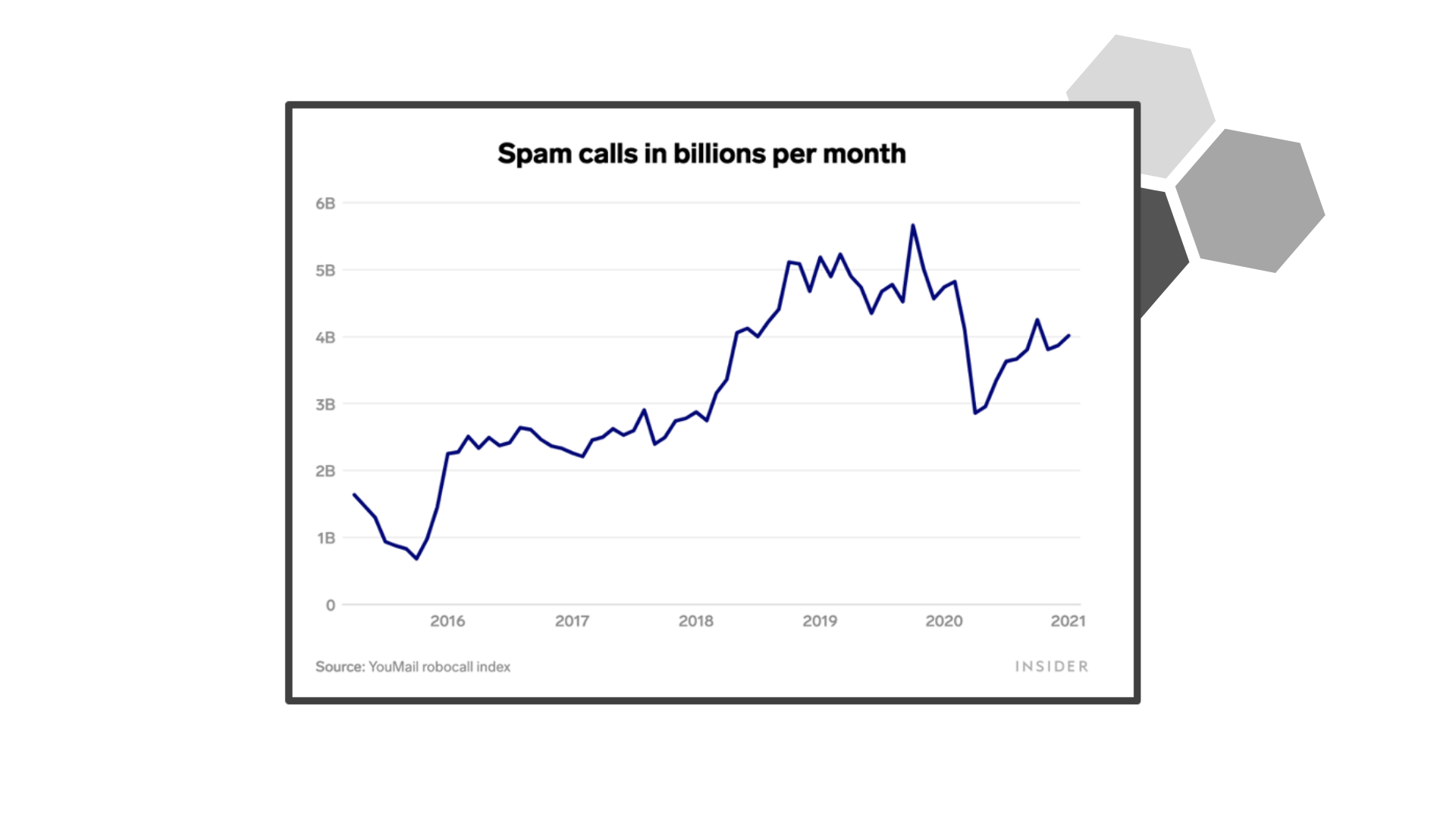Why am I getting more Robocalls recently – how to prevent them?
In the past few years, you may have noticed an influx of spam calls and robocalls. The good news is you’re not alone! In 2019, Americans experienced a 22% increase in robocalls over 2018 – that number dropped during the pandemic in 2020 but is now steadily climbing back to astronomical levels. We’re on pace to receive 51.5 billion robocalls before the end of 2021. Robocall Legislation and Guidelines
Robocall Legislation and Guidelines
Over the past decade, the FCC has implemented a series of actions that have been aimed at protecting consumers from spam calls. In 2003, the FCC and FTC established the “Do Not Call” registry to prevent telemarketers from spamming consumers. In 2012, the FCC revised its rules to require telemarketers to obtain prior express written consent from consumers before robocalling them, to no longer allow telemarketers to use an “established business relationship” to avoid getting consent from consumers, and to require telemarketers to provide an automated, interactive “opt-out” mechanism during each robocall.
As spam call technology has evolved, so too have the FCC guidelines mitigating robocalls. In early April 2021, FCC Acting Chairwoman Jessica Rosenworcel announced her first set of anti-robocall actions to combat unwanted spam calls. These actions include issuing the largest robocall fine in FCC history, demanding certain voice providers cease-and-desist, and launching a Robocall Response Team. The Robocall Response team is a group of more than 50 FCC staff tasked with implementing the agency’s anti-robocall efforts (legal action against robocalls, tracing back calls, and educating providers about ways they can help).
Additionally, phone providers will be required to implement call verification technology by the end of June 2021 under rules approved by the FCC in March. This technology, known as STIR/SHAKEN, allows phone providers to verify that a call is coming from a real number, rather than spam.
In early April, the FCC sent letters to carriers seeking status updates on their robocall-blocking technology. In late March, T-Mobile was the first in the wireless industry to have the STIR/SHAKEN protocol in place with all major U.S. network providers.
On the flip side, the U.S. Supreme Court recently sided with Facebook in a robocall case, which gives large companies legal room to call and text consumers. This SCOTUS decision has many wondering if it may lead to an influx of robocalls in the future with this new legal precedent.
Why am I getting more robocalls recently?
There are many factors that have led to the increase in spam calls in recent years – three of the main reasons are changes in technology, lack of legal recourse for consumers, and opportunity for financial gain for the spam companies.
Technology Improvements
International spam calls are able to place their calls through a gateway carrier, which is a telecommunications company willing to place those calls to American phones. The gateway carrier might not always know they are laundering scam calls into the US, but they are still often targets of FTC enforcement. Once the call is on US soil, it passes through a patchwork of carriers to your phone. These paths into the US phone system allow for thousands of calls to reach people nearly undetected.
Legal Recourse
The avenues for legal recourse are quite narrow and difficult to pursue from a consumer perspective. Most large companies benefit from robocalls, so lobbying groups and government officials do not have as much incentive to prevent spam calls. An Insider analysis found that the federal lobbyists employed by pro-robocall businesses outnumbered the anti-robocall consumer groups’ lobbyists 100-to-1. Additionally, robocalls often originate overseas, where the FTC lacks jurisdiction.
Financial
The financial gain for robocall companies is too good to pass up – even if just one out of every 10,000 calls turns into a qualified lead (at a going rate of $7 per lead), an hour of robocalls will pull in $1,750 in revenue, nearly doubling their investment.
Robocall Targets
A February 2021 Insider survey found that 46% of Americans reported receiving spam phone calls on their cell phones every day, with another 24% receiving them multiple times per week. The states with the most robocalls are Texas and California. These spam calls tend to impact different groups pretty evenly: 80% of Democrats to 79% of Republicans; 76% of men to 78% of women; 72% rich to 71% poor; and 85% old to 66% young.
The age gap is the largest difference from these groups, as spam calls have been known to target the elderly more often. The most common type of robocalls involved car warranties and health-related scams.
Tips to Prevent Robocalls
Below are some methods you can use to block unwanted robocalls on both iPhones and Androids. Carriers also offer some options to avoid these spam calls.
Androids
- Tap the “phone” icon (usually on the bottom of the home screen)
- Once there, tap the three dots in the top right corner of the screen
- Settings > Blocked Numbers
- Next, enable “Block calls from unidentified callers” by pushing the toggle switch to the right
- The caller still leaves a voicemail, and the number will still show up on the “recent calls” display
iPhones
- Go to Settings > Phone
- Scroll down and tap “Silence Unknown Callers”
- Your phone won’t ring, and the calls will go straight to voicemail
- The calls will still show up on your “recent calls” list
AT&T
With AT&T Call Protect, any call that looks normal will show a “V” (for “verified”) on the caller ID screen. Potentially dangerous calls will be blocked and given a “busy” signal. Suspected spam calls will display “Suspected Spam” on the caller ID screen. They will also show categories such as “Political”, “Non-Profit”, “Telemarketer”, “Survey”, or “Robocaller”. This service is available via both an Android and iPhone app.
T-Mobile
Using two related services – T-Mobile Scam ID and Scam Block – can help T-Mobile users prevent spam calls. First, Scam ID marks possible robocalls and suspicious calls. Scam Block blocks such calls before they can ring. There is no app for these – they can simply be activated for free with the following call codes:
- Scam ID: Press #ONI# (#664#), and then the call button
- Scam Block: Press #ONB# (#662#), and then the call button
Verizon
Verizon customers are automatically enrolled in the free version of Call Filter. This comes pre-installed as an app on most Verizon phones. A version with more features – Call Filter Plus – costs $2.99 per month per line for up to two lines and $7.99 per month for three or more lines. The “Plus” version includes Caller ID and automatically blocks spam calls based on your preferred level of risk.
Tips to prevent spam calls from the FCC:
- Don’t answer calls from unknown numbers. If you answer such a call, hang up immediately.
- Caller ID showing a “local” number does not necessarily mean it is a local caller.
- If you answer the phone and the caller – or a recording – asks you to hit a button to stop getting the calls, you should just hang up. Scammers often use this trick to identify potential targets.
- Do not respond to any questions, especially those that can be answered with “Yes.”
- Never give out personal information such as account numbers, Social Security numbers, mother’s maiden names, passwords or other identifying information in response to unexpected calls
- If you get an inquiry from someone who says they represent a company or a government agency, hang up and call the phone number on your account statement, in the phone book, or on the company’s or government agency’s website to verify the authenticity of the request.
- Use caution if you are being pressured for information immediately.
- If you have a voice mail account with your phone service, be sure to set a password for it. Some voicemail services are preset to allow access if you call in from your own phone number. A hacker could spoof your home phone number and gain access to your voice mail if you do not set a password.
- To block telemarketing calls, register your number on the Do Not Call List. Legitimate telemarketers consult the list to avoid calling both landline and wireless phone numbers on the list.



